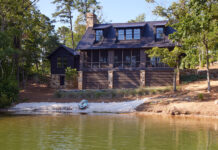If a close-in location is on your new home wish-list, one viable option may be to undertake a historical restoration. Today, popular new homes blend contemporary interiors with historical exteriors. Why settle for a copy if you can have the original? There is a difference between a remodel (reshaping a house any way you like) and a restoration, which stays true to an architectural period. But don’t think a restoration has to be stodgy. A drive through old neighborhoods quickly illustrates Birmingham’s eclectic design heritage.
 Our family restoration project involved an 80-year-old “fixer-upper” on the Jefferson County Historical Register. Though researching a home’s history is easier in the Internet age, I visited the Birmingham Public Library Archives downtown to pull the Board of Equalization files, where I found copies of old photographs and a 1932 appraisal pinpointing a chicken coop and barn. Who knew? While gutting plaster walls to rewire and re-plumb, we found a never-mailed love letter tucked behind an attic doorframe. Old houses have stories to tell, some literally.
Our family restoration project involved an 80-year-old “fixer-upper” on the Jefferson County Historical Register. Though researching a home’s history is easier in the Internet age, I visited the Birmingham Public Library Archives downtown to pull the Board of Equalization files, where I found copies of old photographs and a 1932 appraisal pinpointing a chicken coop and barn. Who knew? While gutting plaster walls to rewire and re-plumb, we found a never-mailed love letter tucked behind an attic doorframe. Old houses have stories to tell, some literally.
Seeing potential in something old is a great metaphor for life; the older I get, the more I appreciate that. If you’re adventurous and have a sense of humor, I highly recommend restoring a home.
A few tips for your project:
1. The website www.antiquehome.org has plan books dating to the late 1800s, where you may find your home’s exact floorplan, helpful if you need to un-do previous remodels.
2. Rewire vintage light fixtures. We found a porch light online for $11, which cost $12 to ship from France and about $40 to rewire. The patina looks original.
3. Homes that predate WWII were built from old growth hardwood. Sand off coats of paint on paneling, flooring and trim, and consider a stain or natural finish. Wood with such character is rare in new construction and costs a premium.
4. Talk to previous owners and friends of the family; this garnered us old photos, several sheets from the original blueprints and a copy of the architect’s rendering, circa 1928.
5. Take more “before” pictures than you think you’ll need, plus a few more, and keep a journal, all of which may end up in a file at the downtown Birmingham Public Library Archives someday.





